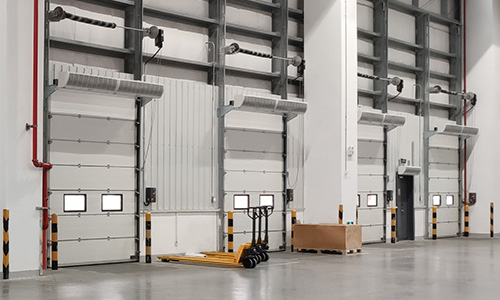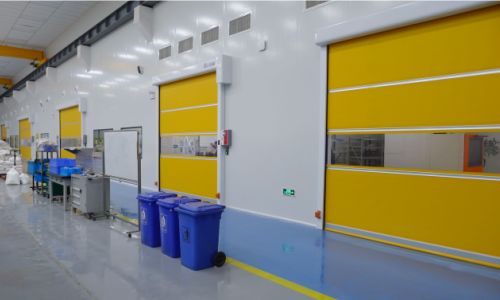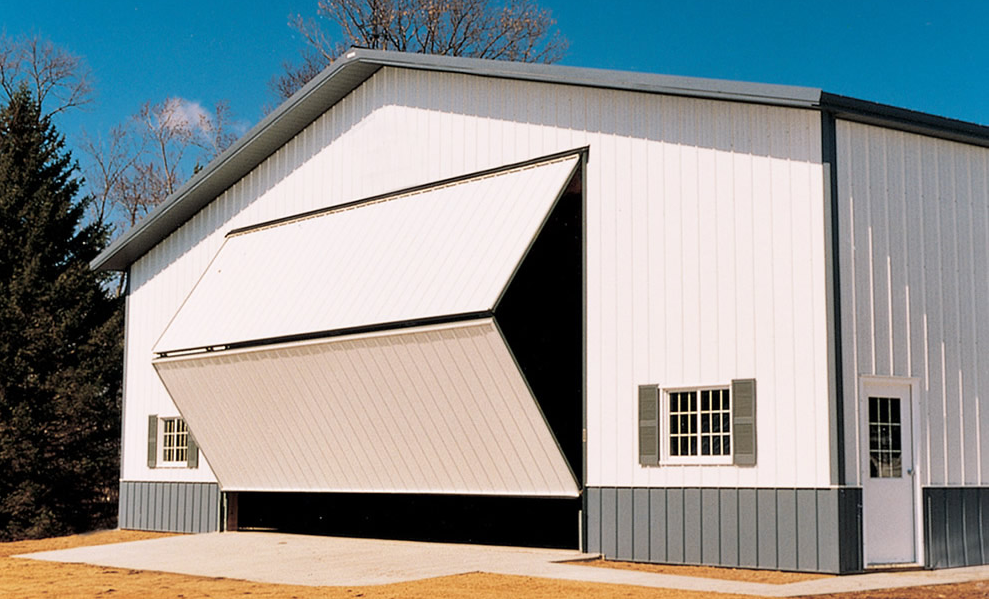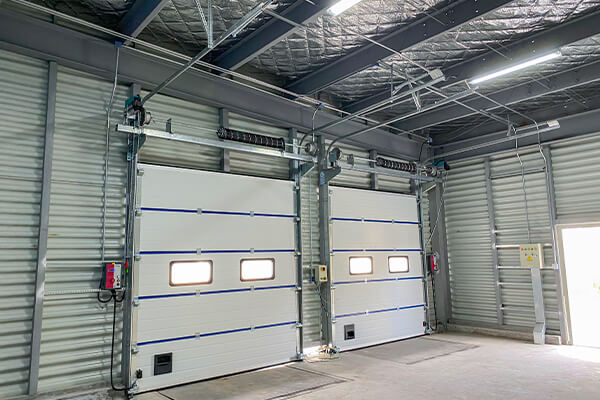In modern industrial environments, the Loading Dock Door is an indispensable key facility in logistics operations. It not only ensures the rapid entry and exit of goods, but also affects storage efficiency, transportation safety and energy management. Choosing the right loading dock door is critical to improving operational efficiency, saving energy and ensuring safety. This article will introduce different types of loading doors and their application scenarios to help you make an informed choice and address common concerns in the industry!
1. What is Loading Dock Door?
Definition: Loading Dock Door is a door body designed for industrial facilities, mainly used for loading and unloading of goods. They are located in the loading and unloading areas of warehouses, logistics centers, factories, etc., and serve as a bridge connecting the interior of the building with the exterior transportation to ensure the efficient flow of goods.
Importance: The Dock Door is not only about logistics efficiency, but also about safety, energy management and temperature control, making it an indispensable core component of industrial facilities.
2. Types and characteristics of Loading Dock Door
According to different application requirements, Loading Dock Door can be divided into the following types:
2.1 Sectional Loading Dock Doors

Description: Sectional Loading Dock Doors are made up of several horizontal panels that open vertically by means of a track. and are commonly used in places that require a high degree of sealing and strong thermal insulation.
Characteristics: Economical and durable, suitable for most industrial environments, with good sound insulation and heat insulation.
Applicable scenarios: logistics warehouses, large-scale production workshops, and industrial facilities that require strong thermal insulation.
2.2 High Speed Roll Up Doors

Description: High Speed Roll Up Doors are designed to open and close quickly and are suitable for high traffic areas and high frequency operations.
Characteristics: fast opening and closing (0.8-1.4 meters/second), save time, improve efficiency, with high sealing performance, dustproof and waterproof.
Applicable scenarios: suitable for manufacturing workshops, food factories, logistics centers and other places that require efficient logistics.
2.3 Dock Leveler Doors

Description: Dock Leveler Doors are doors integrated with the loading platform, which can adjust the height difference between the truck and the platform according to the needs to ensure smooth loading and unloading of goods.
Features: The ability to accurately adjust the height reduces the risk of cargo damage and improves operational safety.
Applicable Scenarios: Warehousing facilities, large distribution centers, and environments that need to handle multiple cargo heights.
2.4 Insulated Loading Dock Doors

Description: Insulated Loading Dock Doors are designed for heat preservation and energy saving, suitable for environments with strict temperature control requirements.
Features: Low U-value to ensure temperature stability in temperature controlled environments and significant energy savings.
Scenario: Cold chain logistics centers, food processing plants, pharmaceutical factories and other places that require temperature control.
2.5 Bi-Fold Loading Dock Doors

Description: Bi-Fold Loading Dock Doors are double-opening design, which makes the door body fold open when opening, very suitable for environments with limited space.
Characteristics: small footprint, suitable for places with limited space, strong security and wind resistance.
Applicable scenes: for small loading and unloading areas, areas with high security requirements.
3. Application scenarios for Loading Dock Doors
Each type of Loading Dock Door is suitable for different industrial places according to its characteristics and functions:
3.1 Warehousing and Distribution Centers
Why use Dock Door: Efficient loading and unloading process is the core of logistics efficiency, choosing the right door body can improve the speed of goods in and out and reduce the waiting time.
Suitable Doors: Sectional Loading Dock Doors and High Speed Roll-Up Doors are widely used in this type of location, providing efficient and smooth operations.
3.2 Food and Pharmaceutical Industry
Why use a Loading Dock Door: These industries have stringent requirements for temperature control and hygiene, and it is important to choose a door that is tightly sealed and able to maintain ambient temperatures.
Applicable Doors: Insulated Loading Dock Doors and High Speed Roll-Up Doors help maintain temperature stability and prevent contamination.
3.3 Logistics and Distribution Centers
Why use a Loading Dock Door:High-volume, high-frequency logistics transportation requires doors that open and close quickly to ensure the rapid flow of goods.
Suitable Doors: High Speed Roll-Up Doors are ideal for such locations, opening and closing quickly and maintaining an efficient logistics flow.
3.4 Cold chain logistics centers
Why use a Dock Door: Temperature controlled environments are critical, and insulated doors can help control the temperature, prevent cold air from escaping, and ensure the quality of the goods.
Applicable Door Body: Insulated Loading Dock Doors provide good temperature control and are suitable for cold chain logistics.
4. Why is Loading Dock Door so important?
4.1 Enhance efficiency
Fast opening and closing: The fast opening speed of high-speed rolling doors greatly improves logistics efficiency and reduces waiting time for loading and unloading goods.
Increase productivity: Automated door body reduces the need for manual operation and improves overall productivity.
4.2 Safety
Reduced accidents: Proper door design reduces accidents during loading and unloading operations, such as falling cargo or injuries to personnel.
Enhanced safety: certain door bodies can be equipped with intelligent safety systems, such as sensors and infrared devices. To effectively avoid collisions and accidental injuries.
4.3 Energy saving and environmental protection
Thermal insulation: Door bodies suitable for temperature-controlled environments can effectively reduce cold air loss and energy consumption.
High efficiency: Reduce the energy waste generated by frequent opening and closing of the door, and reduce operating costs.
5. How to choose the right Loading Dock Door?

5.1 Matching with Industry Requirements
Choose the door body according to the industry needs. For example, food and pharmaceutical industries need doors with strong insulation and good sealing, while logistics centers need door bodies with high-frequency opening and closing.
5.2 Comprehensive consideration of technical parameters
Therefore, it is important to select appropriate opening and closing speed, wind resistance, sealing, durability, and other technical parameters to ensure that the door body adapts to the actual operational needs.
5.3 Brand and after-sales service
Select brands with good market reputation to ensure the provision of all-round after-sales support and technical guarantee.
6. Frequently Asked Questions (FAQ)
Q1: What is the lifespan of a Loading Dock Door?
A1: A high quality Dock Leveler Door will typically last 10 years or more, depending on frequency of use and maintenance.
Q2: Can I customize my Dock Door?
A2: Yes, many suppliers offer customization services to meet your specific needs (e.g. size, material, color, etc.).
Q3: Are Loading Dock Doors suitable for harsh environments?
A3: Many Loading Dock Doors are made of durable materials and offer high wind and impact resistance, making them suitable for harsh environments.
7. Summary of Loading Dock Door
When choosing the right Dock Door, it is important to consider industry needs, door performance and technical parameters. Whether it’s temperature control needs, logistical efficiency or security, an efficient and suitable door body can significantly improve operational efficiency, reduce costs and increase overall productivity. By thoroughly evaluating the advantages and disadvantages of each door type. You can select the most appropriate Loading Dock Door solution for your organization to ensure smooth and efficient operations.





